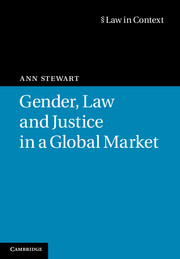Book contents
- Frontmatter
- Contents
- Figures
- Acknowledgements
- Abbreviations
- Introduction Living in a Global North consumer society
- 1 Constructing relationships in a global economy
- 2 Globalising feminist legal theory
- 3 State, market and family in a Global North consumer society
- 4 Gender justice in Africa
- 5 From anonymity to attribution
- 6 Constructing body work
- 7 Global body work markets
- 8 Constructing South Asian womanhood through law
- 9 Trading and contesting belonging in multicultural Britain
- Conclusion
- References
- Index
1 - Constructing relationships in a global economy
Published online by Cambridge University Press: 05 June 2012
- Frontmatter
- Contents
- Figures
- Acknowledgements
- Abbreviations
- Introduction Living in a Global North consumer society
- 1 Constructing relationships in a global economy
- 2 Globalising feminist legal theory
- 3 State, market and family in a Global North consumer society
- 4 Gender justice in Africa
- 5 From anonymity to attribution
- 6 Constructing body work
- 7 Global body work markets
- 8 Constructing South Asian womanhood through law
- 9 Trading and contesting belonging in multicultural Britain
- Conclusion
- References
- Index
Summary
Introduction
The last chapter told a story of cultural identities and economic processes. This chapter considers the impact of the global economy on gender relations, in particular its effects on divisions of labour. The chapter is divided into two sections that introduce two conceptual ‘tools’, which underpin the framework set out in Figure 1 in the Introduction. The first is the gender pyramid, which provides a gender perspective on the ways in which the distribution of productive and socially reproductive labour embodied in ‘gender contracts’ impacts on women’s position within formal labour markets in contemporary processes of globalisation. It considers the effect of regulatory interventions on the construction of the ‘worker’, which reinforce gender injustices. It therefore addresses issues relating to the vertical relationships between state, market and family within the framework of this book. It assesses the implications of the increasing involvement of women as workers within global production processes that have relocated much mass production to countries in the Global South. The basis for historic gender contracts, in which women took responsibility for maintaining the household while men provided its income, are undermined, while the gender norms upon which these contracts are based are yet to change significantly, producing gender injustice.
- Type
- Chapter
- Information
- Gender, Law and Justice in a Global Market , pp. 10 - 38Publisher: Cambridge University PressPrint publication year: 2011



